Dialog Semiconductor SC14D DECT Module User Manual AN D 211 Rev0 6
Dialog Semiconductor BV DECT Module AN D 211 Rev0 6
Contents
- 1. User Manual
- 2. user manual SC14CVMDECT
- 3. user manual SC14WAMDECT
User Manual
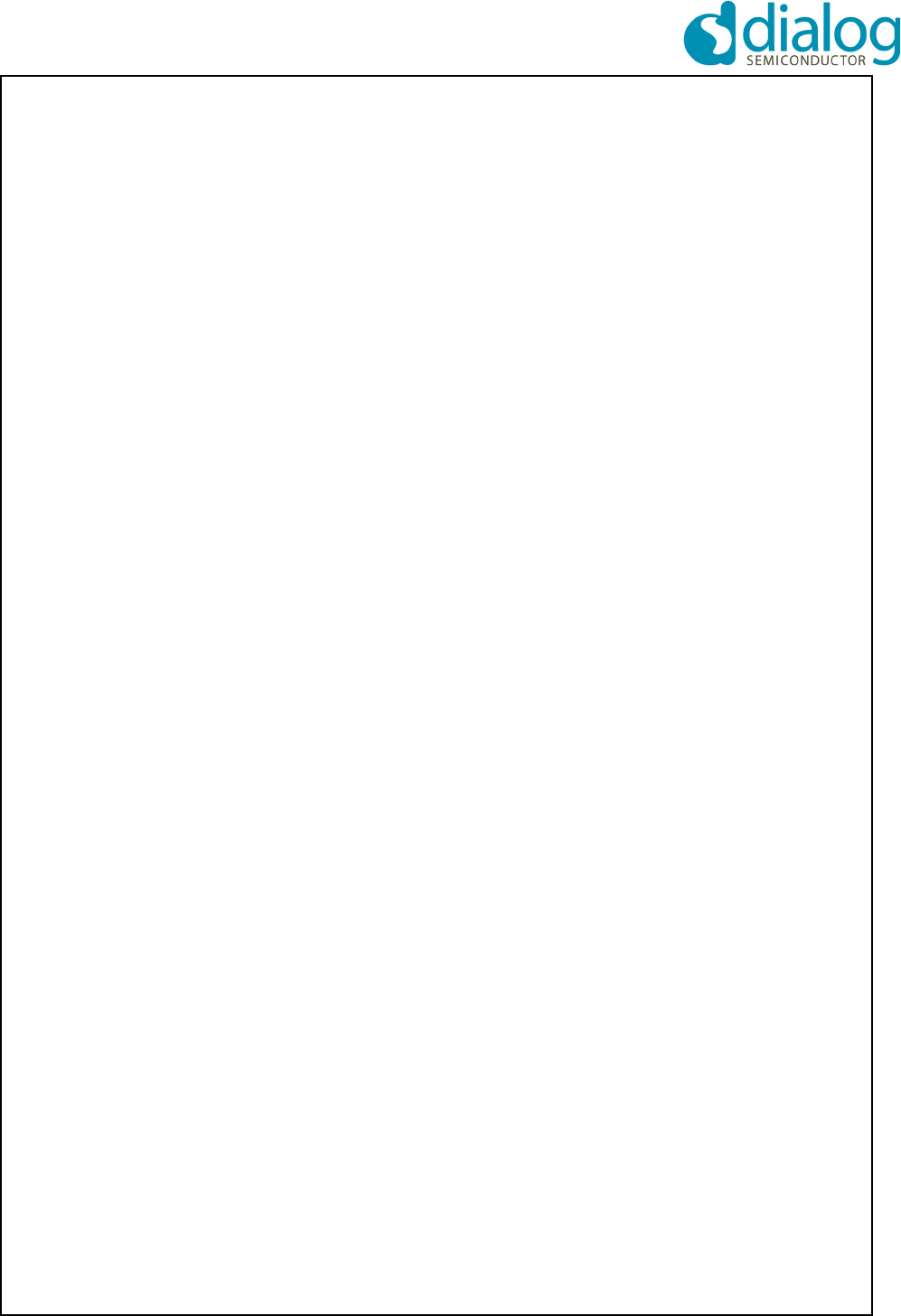
© 2013 Dialog Semiconductor B.V. Company Confidential 1 www.dialog-semiconductor.com
APPLICATION NOTE
AN-D-211 External Antenna Design and Leveraging Modular Approval for CVMDECT
Abstract
This document describes the Modular Approval condi-
tions and how to leverage the existing Dialog regula-
tory certificate when certifying an end-product that
includes CVMDECT.
Table of Contents
1.0 Introduction . . . . . . . . . . . . . . . . . . . . . . . . . . . . . . 1
1.1 TERMS AND ABBREVIATIONS . . . . . . . . . . . . 1
1.2 REFERENCES . . . . . . . . . . . . . . . . . . . . . . . . . 1
1.3 HISTORY . . . . . . . . . . . . . . . . . . . . . . . . . . . . . 1
1.4 DISCLAIMER . . . . . . . . . . . . . . . . . . . . . . . . . . 1
2.0 Modular Approval. . . . . . . . . . . . . . . . . . . . . . . . . . 2
2.1 DESCRIPTION . . . . . . . . . . . . . . . . . . . . . . . . . 2
2.2 AVAILABLE CERTIFICATIONS . . . . . . . . . . . . . 2
2.3 APPLICABILITY . . . . . . . . . . . . . . . . . . . . . . . . 2
2.4 CONDITIONS . . . . . . . . . . . . . . . . . . . . . . . . . . 2
2.4.1 ANTENNA . . . . . . . . . . . . . . . . . . . . . . . . 2
2.4.2 TRANSMITTER ANTENNA . . . . . . . . . . . 2
2.4.3 HOST PCB LAYOUT . . . . . . . . . . . . . . . . 3
2.4.4 LABELLING REQUIREMENTS . . . . . . . . 3
2.4.5 USER DOCUMENTATION TEXT . . . . . . 3
2.4.6 SAFETY REQUIREMENTS . . . . . . . . . . . 4
2.5 MISCELLANEOUS COMMENTS. . . . . . . . . . . . 4
3.0 External Antenna Design. . . . . . . . . . . . . . . . . . . . 5
3.1 SC14CVMDECT_AF01_SF01 CONVERSION
BOARD . . . . . . . . . . . . . . . . . . . . . . . . . . . . . . . 5
3.1.1 BOUNDARY CONDITIONS . . . . . . . . . . . 5
3.2 HOST PCB PRINTED ANTENNA DESIGN . . . . 6
3.3 OTHER ANTENNAS . . . . . . . . . . . . . . . . . . . . . 6
1.0 Introduction
Dialog Semiconductor B.V. has obtained a Modular
Approval Certificate (US, EU) for CVMDECT. When
meeting the conditions as referenced in this document,
this implies that those tests already covered by the
Modular Approval Certificate don’t need to be rerun on
the end-product level. This may alleviate the overall
regulatory approval process of the end-product.
1.1 TERMS AND ABBREVIATIONS
DoC Declaration of Conformity
EU Europe
ETSI European Telecommunications
Standards Institute
FAD Fast Antenna Diversity
FCC Federal Communications Com-
mission
FP Fixed Part
IC Industry Canada
JP Japan
MIC Ministry of Internal affairs and
Communications
SAR Specific Absorption Rate
TCF Technical Construction File
1.2 REFERENCES
1. SC14CVMDECT SF01 Datasheet v1.00 Data
sheet, Dialog Semiconductor B.V.
2. FCC document “DA-00-1407”
3. FCC document "784748 D01 Labelling Part 15
18 Guidelines v07"
4. FCC document “D01 Mobile Portable RF Expo-
sure v04”
5. FCC order “04-165”
1.3 HISTORY
June 24, 2013, v0.1 Initial version
June 28, 2013, v0.2 Added section “External
Antenna Design”
November 14, v0.3 Added FCC/IC text
January 28 ‘14 v.06 Minor editorial changes
1.4 DISCLAIMER
This document is for general information purposes
only. Dialog Semiconductor B.V. does not guarantee
the completeness, correctness or accuracy of the infor-
mation in this document and shall not be liable for any
direct or indirect loss or damage arising from the use of
information or documents found in it.
Please consult with your test house when planning for
and/or undertaking any action with respect to regula-
tory certification.
AN-D-211: External Antenna Design and Leveraging Modular
Approval for CVMDECT
JANUARY 28, 2014 V0.6
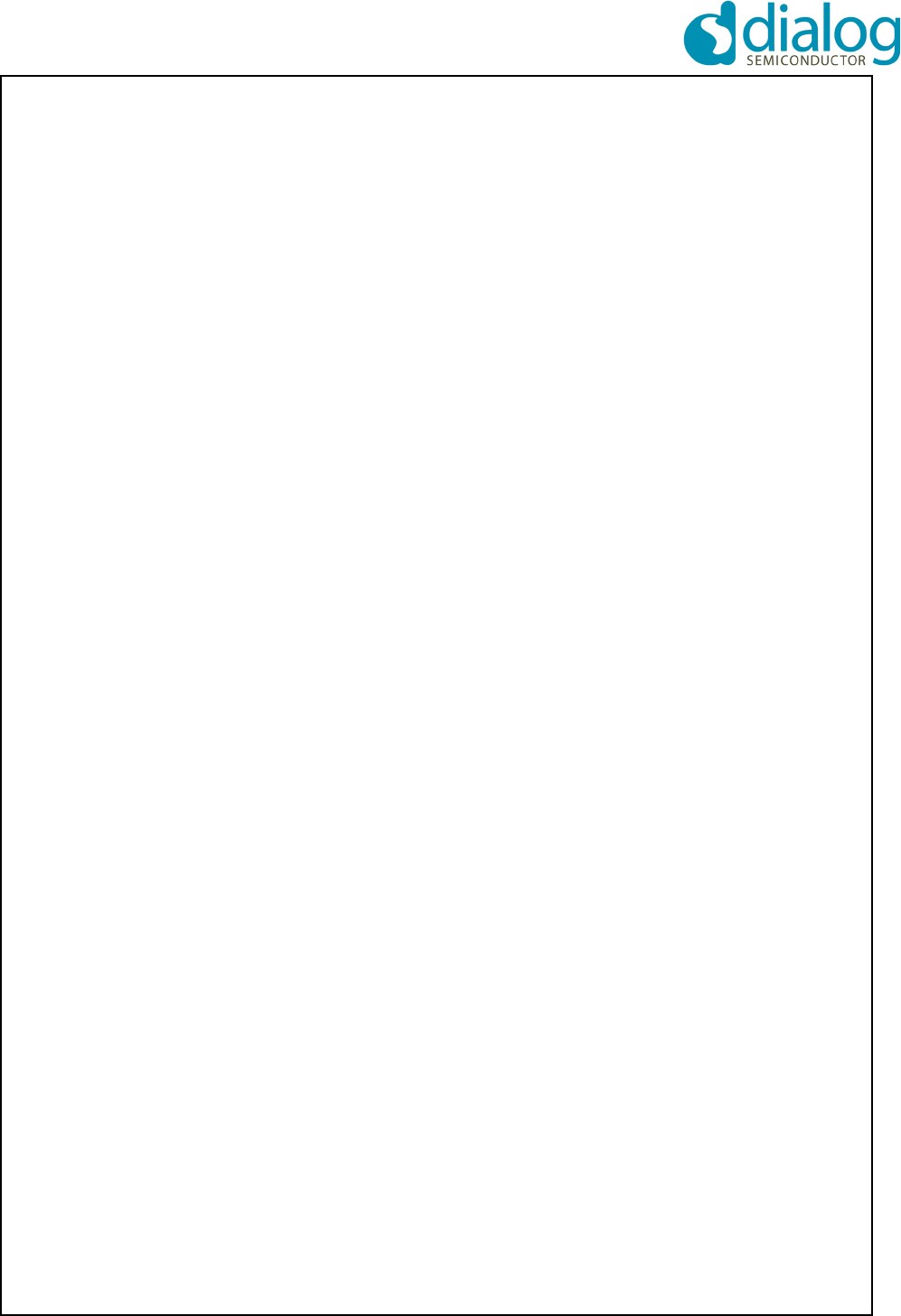
AN-D-211 External Antenna Design and Leveraging Modular Approval for CVMDECT
© 2013 Dialog Semiconductor B.V. Company Confidential 2 June 28, 2013 v0.2
2.0 Modular Approval
2.1 DESCRIPTION
When a wireless module has passed the Modular
Approval process, and when the host conforms to cer-
tain conditions (this will be detailed in the subsequent
sections), then the end-product containing this module
will not need to be tested against the regulatory stand-
ards covered by the module’s certificates.
The availability of the Modular Approval is intended to
reduce time, cost and effort putting an end-product
containing CVMDECT on the market.
2.2 AVAILABLE CERTIFICATIONS
Dialog Semiconductor B.V. has obtained the following
modular approvals for CVMDECT:
• FCC Part 15, subpart D, Isochronous UPCS Device
1920-1930 MHz: FCC ID Y82-SC14D
• IC RSS-213, issue 2, 2GHz License-exempt Per-
sonal Communications Service Devices: IC ID
9576A-SC14D
In addition, testing has shown compliance to the follow-
ing:
• EU testing (to be used in the DoC process when
applicable:
• Emissions EN 301-406
• Immunity EN 301-489
• CE IECEN 60950-1
• SAR EN 62311
• JP Radio Law pre-test
2.3 APPLICABILITY
Only FCC (US) and IC (Canada) officially support Mod-
ular Certification.
ETSI (Europe) doesn’t supports Modular Certification,
rather Declaration of Conformity (DoC). The manufac-
turer is responsible for the compliance to regulatory
requirements. Previous testing, such as made availa-
ble by Dialog Semiconductor B.V., may be taken into
consideration by the module integrator. If module test-
ing is trusted for the DoC of the host, the module’s
Technical Construction File (TCF) becomes part of the
host’s TCF.
This is part of the “self certification” process where the
end-product OEM declares conformity to regulatory
requirements. The available ETSI test reports may be
used to this purpose and the tests in these reports
don’t need to be repeated on end-product/system level.
MIC (Japan) announced incorporation of modular
approvals in Japanese Radio Law (Feb ‘13). Require-
ments are being developed now. Currently, there is no
timeline or estimated implementation date. Modular
Certification is still judged on a case-by-case basis.
Other countries may not support Modular Certification.
The available test reports may help expedite the sys-
tem level certification process though.
Any regulatory standards not covered by the available
Modular Approval certificates will still need to be tested
on end-product/system level.
2.4 CONDITIONS
The FCC document “DA-00-1407” provides a clear
overview of the conditions applicable to the host, asso-
ciated with leveraging existing Modular Approval.
With respect to CVMDECT, the following subsections
reference the relevant conditions that have to be met.
Not adhering to these will invalidate the certification,
requiring recertification on end-product/system level.
2.4.1 Antenna
The FCC document “DA-00-1407” specifies:
• The antenna gain of a new antenna should be of the
same type as the originally approved antenna and
the antenna gain should not be higher than the
antenna gain of the originally tested antenna.
• The emission levels or reported RF safety levels
shall not be increased by the new antenna (of the
same antenna type)
• If the new antenna is a different type, recertification
on end-product/system level is required.
With the existing CVMDECT certification this implies
the following:
• If only the embedded/internal antenna of CVMDECT
is used, then the Antenna Condition is fulfilled
• If an external antenna is connected to CVMDECT,
then this antenna would need to meet specific crite-
ria in order to prevent recertification requirements.
Please refer to section 3.0 for further details.
2.4.2 Transmitter Antenna
Under Industry Canada regulations, this radio transmit-
ter may only operate using an antenna of a type and
maximum (or lesser) gain approved for the transmitter
by Industry Canada. To reduce potential radio interfer-
ence to other users, the antenna type and its gain
should be so chosen that the equivalent isotropically
radiated power (e.i.r.p.) is not more than that neces-
sary for successful communication.
Conformément à la réglementation d'Industrie Canada,
le présent émetteur radio peut fonctionner avec une
antenne d'un type et d'un gain maximal (ou inférieur)
approuvé pour l'émetteur par Industrie Canada. Dans
le but de réduire les risques de brouillage radioélectri-
que à l'intention des autres utilisateurs, il faut choisir le
type d'antenne et son gain de sorte que la puissance
isotrope rayonnée équivalente (p.i.r.e.) ne dépasse pas
l'intensité nécessaire à l'établissement d'une communi-
cation satisfaisante.
Under Industry Canada regulations, this radio transmit-
ter may only operate using an antenna of a type and
maximum (or lesser) gain approved for the transmitter
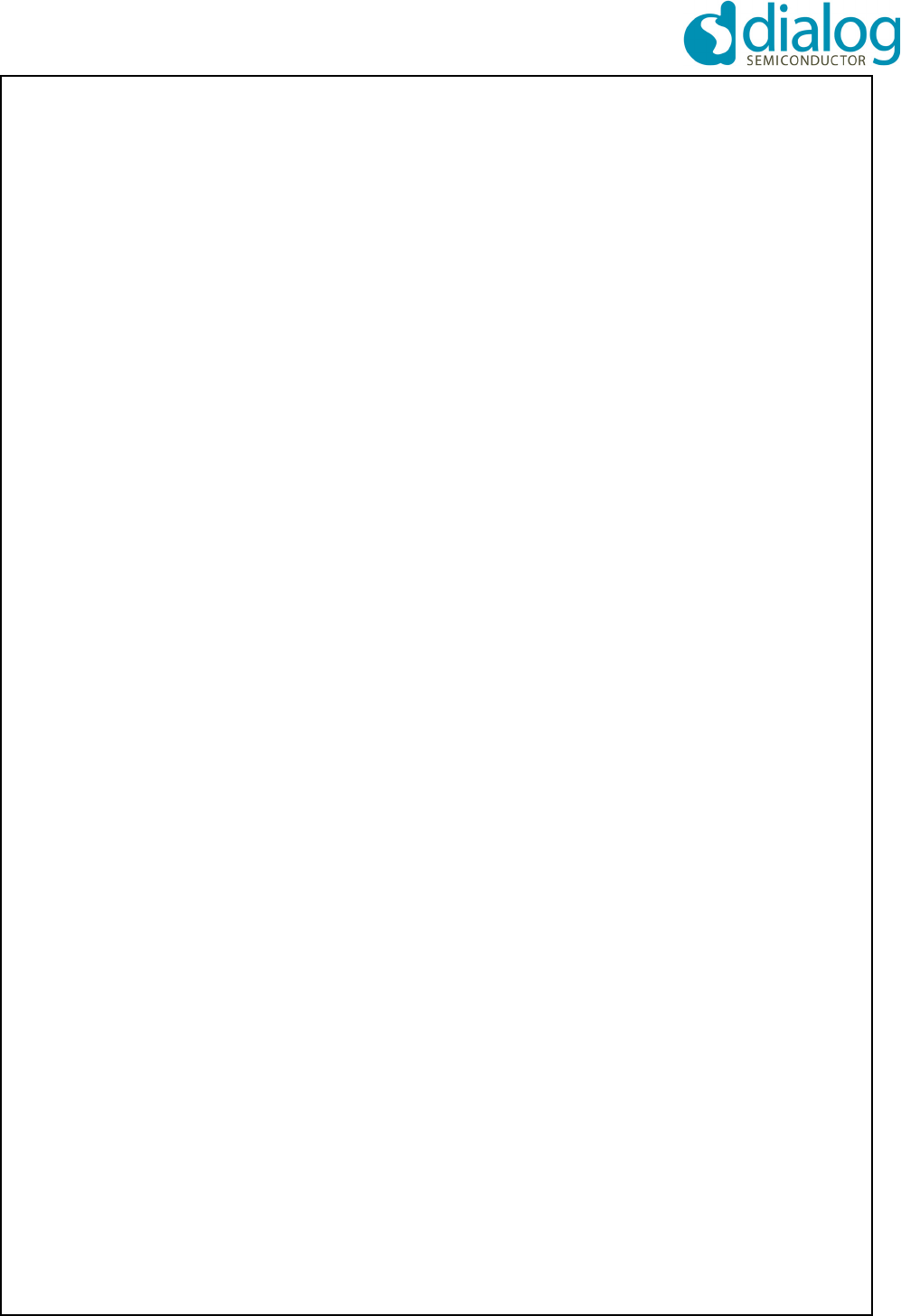
AN-D-211 External Antenna Design and Leveraging Modular Approval for CVMDECT
© 2013 Dialog Semiconductor B.V. Company Confidential 3 June 28, 2013 v0.2
by Industry Canada. To reduce potential radio interfer-
ence to other users, the antenna type and its gain
should be so chosen that the equivalent isotropically
radiated power (e.i.r.p.) is not more than that neces-
sary for successful communication.
Le présent émetteur radio (identifier le dispositif par
son numéro de certification ou son numéro de modèle
s'il fait partie du matériel de catégorie I) a été approuvé
par Industrie Canada pour fonctionner avec les types
d'antenne énumérés ci-dessous et ayant un gain
admissible maximal et l'impédance requise pour
chaque type d'antenne. Les types d'antenne non inclus
dans cette liste, ou dont le gain est supérieur au gain
maximal indiqué, sont strictement interdits pour
l'exploitation de l'émetteur.
2.4.3 Host PCB layout
The PCB layout of the host PCB is critical to the validity
of the RF certification of CVMDECT because it is part
of the embedded printed antenna. Please refer to sec-
tions 7.4 and 7.5 of the SC14CVMDECT SFxx data-
sheet for details.
2.4.4 Labelling Requirements
FCC
The modular transmitter must be labelled with its own
FCC ID number. If the FCC ID is not visible when the
module is installed inside another device, then the host
device must contain the FCC ID number with the state-
ment such as the following: "Contains FCC ID: Y82-
SC14D".
Some further details about labelling requirements and
compliance statements can be found in "784748 D01
Labelling Part 15 18 Guidelines v07".
IC (Canada)
The host device shall be properly labelled to identify
the modules within the host device. The Industry Can-
ada certification label of a module shall be clearly visi-
ble at all times when installed in the host device,
otherwise the host device must be labelled to display
the Industry Canada certification number of the mod-
ule, preceded by the words “Contains transmitter mod-
ule”, or the word “Contains”, or similar wording
expressing the same meaning, as follows:
Contains transmitter module IC: 9576A-SC14D
L'appareil hôte doit être étiqueté comme il faut pour
permettre l'identification des modules qui s'y trouvent.
L'étiquette de certification d'Industrie Canada d'un
module donné doit être posée sur l'appareil hôte à un
endroit bien en vue en tout temps. En l'absence d'éti-
quette, l'appareil hôte doit porter une etiquette donnant
le numéro de certification du module d'Industrie Can-
ada, précédé des mots « Contient un module d'émis-
sion », du mot « Contient » ou d'une formulation
similaire exprimant le même sens, comme suit :
Contient le module d'émission IC: 9576A-SC14D
2.4.5 User Documentation Text
The literature provided to the end user must include the
following wording:
“FCC compliance statement
This device complies with Part 15 of the FCC Rules.
Operation is subject to the following two conditions:
(1) this device may not cause harmful interference, and
(2) this device must accept any interference received,
including interference that may cause undesired opera-
tion of the device.
Module transmetteur ID IC:
This device complies with Industry Canada licence-
exempt RSS standard(s). Operation is subject to the
following two conditions: (1) this device may not cause
interference, and (2) this device must accept any inter-
ference, including interference that may cause unde-
sired operation of the device.
Le présent appareil est conforme aux CNR d'Industrie
Canada applicables aux appareils radio exempts de
licence. L'exploitation est autorisée aux deux condi-
tions suivantes :
(1) l'appareil ne doit pas produire de brouillage, et
(2) l'utilisateur de l'appareil doit accepter tout brouillage
radioélectrique subi, même si le brouillage est suscep-
tible d'en compromettre le fonctionnement.
Changes or modifications to the equipment not
expressly approved by the Party responsible for com-
pliance could void the user's authority to operate the
equipment.
NOTE: This equipment has been tested and found to
comply with the limits for a Class B digital device, pur-
suant to Part 15 of the FCC Rules. These limits are
designed to provide reasonable protection against
harmful interference in a residential installation. This
equipment generates, uses and can radiate radio fre-
quency energy and, if not installed and used in accord-
ance with the instructions, may cause harmful
interference to radio communications. However, there
is no guarantee that interference will not occur in a par-
ticular installation. If this equipment does cause harm-
ful interference to radio or television reception, which
can be determined by turning the equipment off and
on, the user is encouraged to try to correct the interfer-
ence by one or more of the following measures:
• Reorient or relocate the receiving antenna
• Increase the separation between the equipment and
receiver
• Connect the equipment into an outlet on a circuit dif-
ferent from that to which the receiver is connected.
• Consult the dealer or an experienced radio/TV tech-
nician for help.
Privacy of communications may not be ensured when
using this phone.”
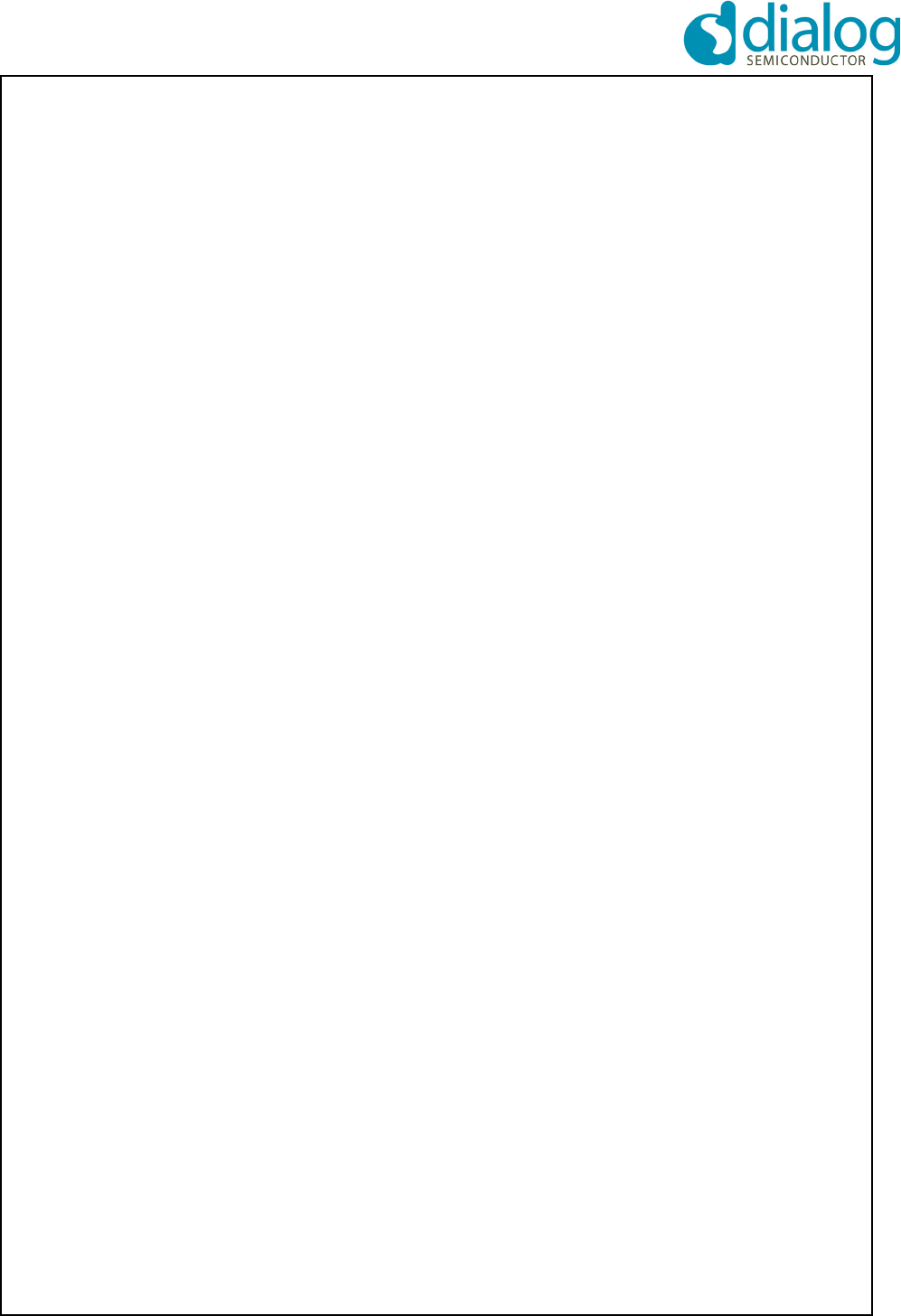
AN-D-211 External Antenna Design and Leveraging Modular Approval for CVMDECT
© 2013 Dialog Semiconductor B.V. Company Confidential 4 June 28, 2013 v0.2
ITE Class: CAN ICES-3 (B)/NMB-3(B).
2.4.6 Safety Requirements
This section provides of an overview of the safety
requirements you must adhere to when working with
CVMDECT.
• The specific external power supply for CVMDECT
has to fulfil the requirements according to clause 2.5
(Limited power source) of this standard EN 60950-
1:2006.
• Interconnection circuits shall be selected to provide
continued conformance to the requirements of
clause 2.2 for SELV (Safety Extra Low Voltage) cir-
cuits according to EN 60950-1:2006 after making
connections
• Interface type not subjected to over voltages
• Requirements additional to those specified in this
standard may be necessary for:
• Equipment intended for operation in special envi-
ronments (for example, extremes of temperature,
excessive dust, moisture or vibration, flammable
gases and corrosive or explosive atmospheres)
• Equipment intended to be used in vehicles, on
board ships or aircraft, in tropical countries or at
altitudes greater than 2000m
• Equipment intended for use where ingress of
water is possible
• Installation by qualified personnel only
• The product is a component intended for installation
and use in complete equipment. The final accept-
ance of the component is dependent upon its instal-
lation and use in complete equipment
2.5 MISCELLANEOUS COMMENTS
In FCC terminology, a “Host” is what is referred to in
DECT as a “fixed part”. The FCC term “Mobile” corre-
sponds with the DECT term “portable part”, provided
that the device is >20cm from the human body. A
DECT termed “portable part” <20cm from the human
body is referred to as “Portable” in FCC terminology.
The antenna(s) used for this transmitter must be
installed to provide a separation distance of at least 20
cm from all persons and must not be co-located or
operating in conjunction with any other antenna or
transmitter.
Une distance de séparation de 20cm ou plus doit être
maintenue entre cet appareil et des personnes lors de
fonctionnement du dispositif. L’antenne utilisée pour ce
transmetteur ne doit pas être co-localisés en conjonc-
tion avec toute autre antenne ou transmetteur.
A Permissive Change to the Modular Approval can
only be issued by the Grantee (i.e. Dialog Semiconduc-
tor B.V.). Therefore, any change to the module and/or
its connections will require submission for a new FCC
ID by the customer (either on module level or system
level).
The existing Modular Approval may be invalidated if
CVMDECT is co-located with other wireless devices
(e.g. BlueTooth, WLAN/WiFi) that transmit simultane-
ously. Please consult with your test house on the possi-
ble implications.
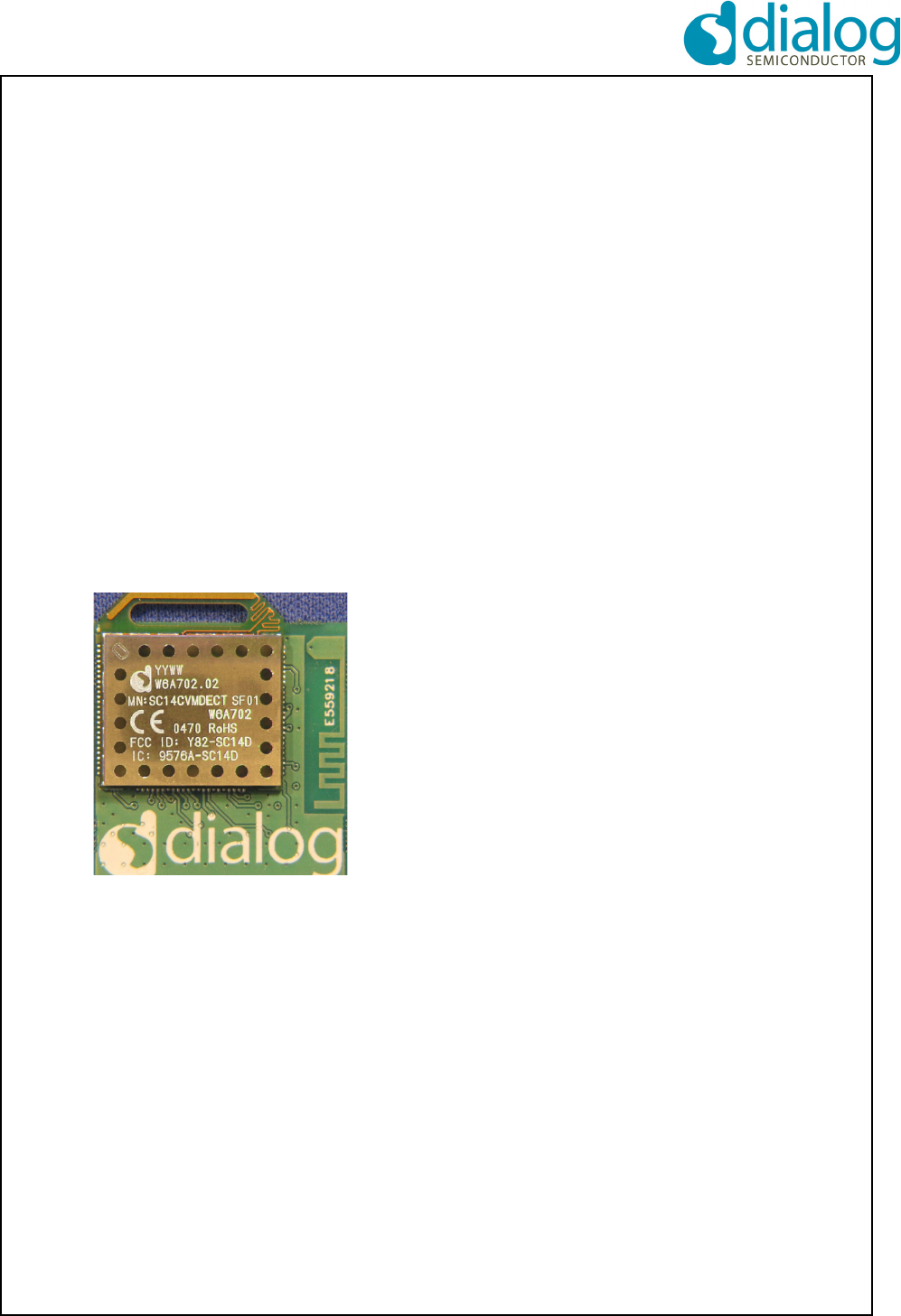
AN-D-211 External Antenna Design and Leveraging Modular Approval for CVMDECT
© 2013 Dialog Semiconductor B.V. Company Confidential 5 June 28, 2013 v0.2
3.0 External Antenna Design
FCC-04-165 now allows different antennas may be
certified with one module. Dialog Semiconductor B.V.
has obtained Modular Approval for CVMDECT using a
specific external printed antenna. FCC-04-165 dictates
that the certification measurements must to be per-
formed with the highest gain antenna and any other
antenna must have a similar radiation pattern.
For CVMDECT, this implies that an external antenna
may be connected to radio module, provided that:
• the antenna gain is not higher than -1.2dBi
• the antenna type is a (printed) monopole
In addition, if the antenna connection is user accessi-
ble, then the antenna connector shall be proprietary.
3.1 SC14CVMDECT_AF01_SF01 CONVERSION
BOARD
The “SC14CVMDECT_AF01_SF01” design is a con-
version PCB that holds a SC14CVMDECT SF xx mod-
ule on the top side, while having an SC14CVMDECT
AF compatible footprint on the bottom side. Please
refer to the following indicative picture:
Figure 1 SC14CVMDECT_AF01_SF01 with
SC14CVMDECT SFxx module
This design also has an embedded printed antenna
(located to the top right in the above picture) so that
CVMDECT can support FAD and may have increased
performance to operate as an FP.
The SC14CVMDECT_AF01_SF01 design passed the
Modular Approval testing and can be used as a drop-in
replacement for the SC14CVMDECT AF module with-
out needing to recertify the end-product (for those
countries allowing Modular Approvals, please refer to
section 2.3).
The gerber files of this design can be obtained through
your Dialog Semiconductor B.V. sales contact or repre-
sentative.
3.1.1 Boundary Conditions
In order to be allowed to leverage the CVMDECT Mod-
ular Approval for the SC14CVMDECT_AF01_SF01
design, the PCB should meet the following specifica-
tions:
• PCB material: FR4
• Dimensions: length x width x thickness = 25.9mm x
25.0mm x 0.8mm
• PCB layer stackup:
• L1 copper thickness: 18um
• L1-L2 prepreg thickness: 163um
• L2 copper thickness: 35um
• L2-L3 core thickness: 360um
• L3 copper thickness: 35um
• L3-L4 prepreg thickness 163um
• L4 copper thickness: 18um
The SC14CVMDECT_AF01_SF01 has been designed
using 6mil lines/space and 0.25mm end-size drill holes
rules.
When deviating in any way from these specifications,
the Modular Approval will be invalidated and recertifi-
cation on end-product/system level will be required.
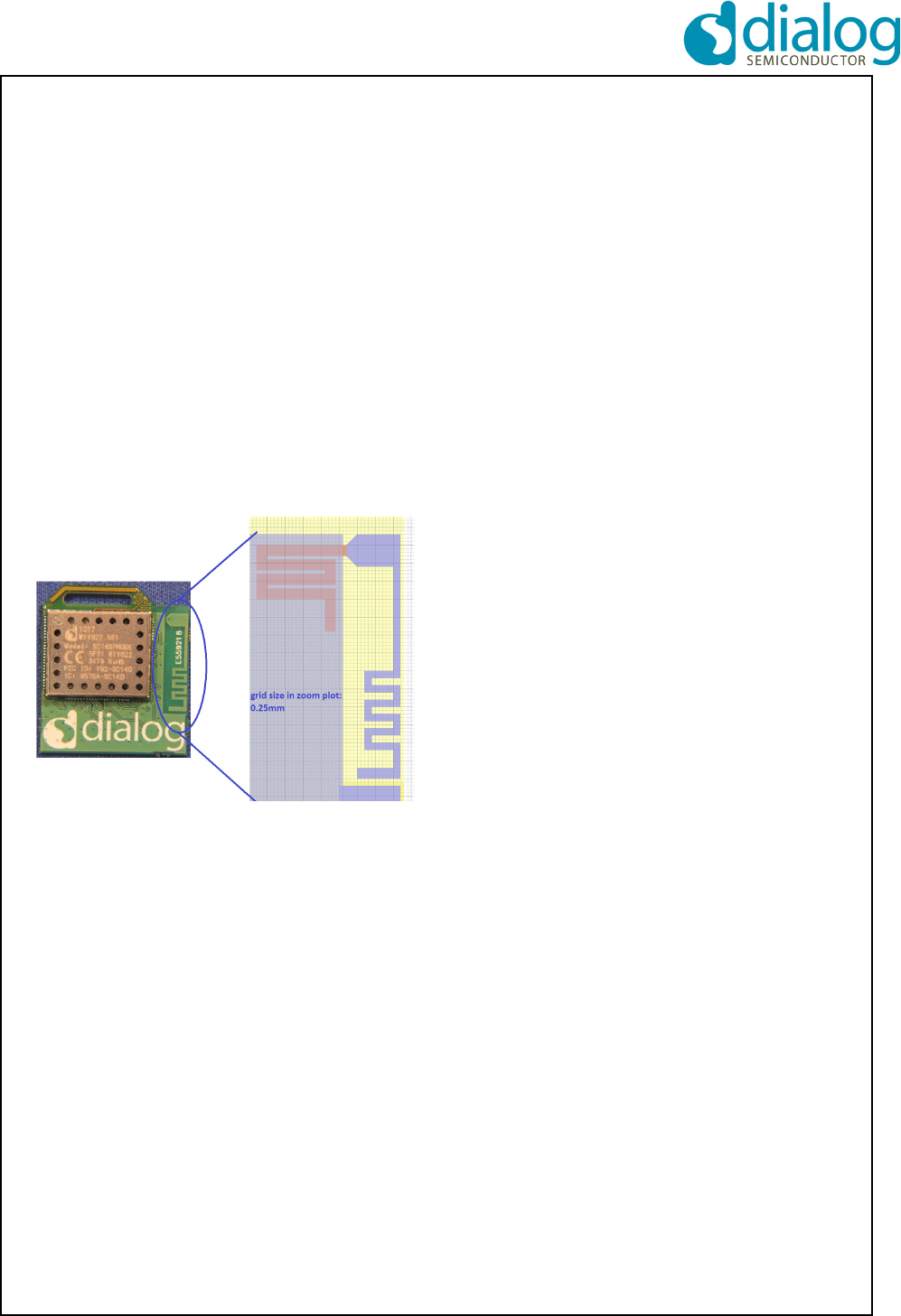
AN-D-211 External Antenna Design and Leveraging Modular Approval for CVMDECT
© 2013 Dialog Semiconductor B.V. Company Confidential 6 June 28, 2013 v0.2
3.2 HOST PCB PRINTED ANTENNA DESIGN
The printed antenna that is part of the SC14CVM-
DECT_AF01_SF01 design can also be used directly,
as part of the host PCB design.
In that case, the host PCB design must adhere to the
same PCB layer stackup (material, layer spacings) as
mentioned in section 3.1.1. The antenna must be
located in a corner and spaced from the SC14CVM-
DECT SFxx module in the same way as the
SC14CVMDECT_AF01_SF01 design. Also the ground
plane design (especially the spacing with respect to the
antenna structure) should follow exactly the same out-
line as in the SC14CVMDECT_AF01_SF01 design.
The printed antenna is not 50 Ohms by itself. It
requires a printed transformer on the inner layer (indi-
cated in red in the below picture) that is part of the
SC14CVMDECT_AF01_SF01 design. The layout of
this component is critical to the antenna performance
and should be copied accurately from the available
gerber files.
Figure 2 SC14CVMDECT_AF01_SF01 printed
antenna design details
Figure 2 here above is only meant to show the basic
design; the picture is from simulation used as a basis
for the actual physical design. The gerber files should
be leading in any customer design.
3.3 OTHER ANTENNAS
If an antenna is connected to CVMDECT that has a
dissimilar radation pattern than that of the SC14CVM-
DECT_AF01_SF01 design and/or if the antenna has a
higher gain than that of the SC14CVM-
DECT_AF01_SF01 design, then FCC-04-165 dictates
that the Modular Approval is invalidated and that recer-
tification is required on end-product/system level.
If the antenna connected to CVMDECT is user acces-
sible, then the antenna connector shall be proprietary
(per FCC DA-00-1407).